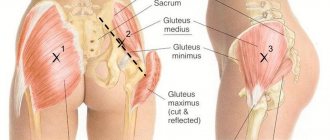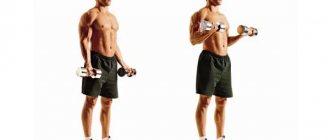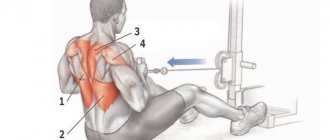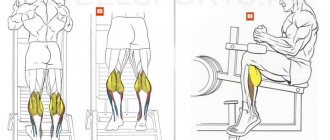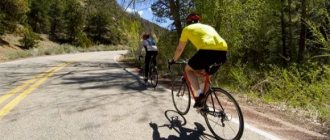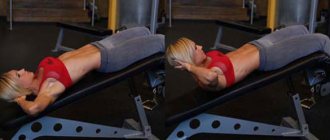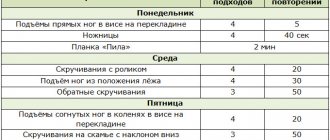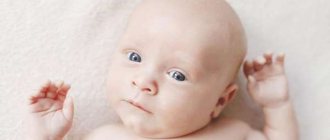Exercises for Tibial Syndrome
Muscle pain syndrome is caused by spasm.
To determine the cause of the pain, you need to analyze your previous day. The reasons may be the following:
- Trauma and overexertion. Pain occurs when the integrity of muscle fibers is damaged and there is increased tone.
- Poor posture. Sitting at a table for a long time in the wrong position, wearing uncomfortable shoes, skewing the body to one side - all these factors contribute to the appearance of pain.
- Emotional stress. Especially typical for children. Stress often causes muscle tone.
- Myalgia. A disease accompanied by insomnia. It is characterized by muscle pain on all sides.
- Excessive physical activity. Typical for men involved in heavy sports or in the gym.
- Myositis. The inflammatory process in muscle fibers develops after infections or injuries. The pain intensifies with movement.
During active exercise in the gym, lactic acid accumulates in the muscles, and microcracks may appear in the fibers. Before each approach, it is recommended to shake the limb to disperse the fluid that puts pressure on the nerve endings.
Pain after training can be natural or pathological. Natural ones occur in the following cases:
- after the first workout, since the body is not yet accustomed to the stress;
- after a long break;
- when adding new exercises to the program;
- with increased intensity of exercise.
To relieve pain of this nature, it is enough to stretch and take a warm shower after finishing the workout.
Pathological pain is characterized by severity and duration. Occurs in cases:
- incorrect execution of exercises;
- classes without warming up and stretching;
- poor nutrition;
- excessive physical activity.
Additional symptoms may appear - hematomas, swelling. If such pain occurs, you must stop training and immediately consult a doctor. In the future, it is important to give the muscles proper rest between workouts so that they have time to recover.
Lack of sleep, daily grueling workouts, poor nutrition - all these factors have a detrimental effect on the condition of the muscles.
Types of calf muscles
If you experience pain in your tibialis anterior muscle, it is likely due to a condition called anterior tibial syndrome, or shin splints. There are several factors causing this condition:
- Flattened arch of the foot (flat feet). Causes a divergence of the bones between the shin and the metatarsus, this increases the load on the tendons of the front of the shin and provokes pain in the lower third.
- Tendinitis. Inflammation can affect all tendons of the leg. It occurs mainly due to running on unsuitable surfaces, which causes one foot to regularly roll inward. A one-time increased pronation (dislocation) can also cause tendinosis.
- Tenosynovitis. Another type of inflammatory process. Localized in the tissues of the tendon sheath.
- Syndrome of the anterior fascial bed of the leg. Injuries that cause swelling of muscle tissue (bruises) create pressure in the area where the deep peroneal nerve and anterior tibial vessels - artery and vein - are located.
- Stress fractures. This bone damage is the result of increased physical activity. It occurs most often in sprinters and marathon runners. The manifestation of tibial syndrome in this case is preceded by inflammation of the periosteum.
- Insufficient recovery from previous injury. Enough time must pass for the ligaments to recover, otherwise the risk of relapse is high.
- A sharp increase in physical activity. The workout should begin with a warm-up, and its intensity should correspond to the person’s level of training.
With the development of tibial syndrome, pain in the lower leg is noted, which is especially severe in the morning. In advanced cases, pain is felt when moving, discomfort during palpation and swelling. If neuralgia occurs, that is, damage to the nerve, the patient’s gait changes, it becomes awkward, with emphasis on the toes.
As soon as you feel that the tibialis anterior muscle hurts when walking or begins to cramp, you must urgently reduce the load and consult a doctor.
Cold compress to neutralize inflammation in the knee area
Treatment for the syndrome does not require you to stop training completely. However, it is necessary to regularly provide rest to the injured limb.
If your tibialis anterior muscle hurts when running, you may want to increase your cadence by 10%.
It is also necessary to apply cold to the injured limb to neutralize inflammation. The main rule is to wrap the ice in a towel to prevent direct contact with the skin. As part of anti-inflammatory therapy, you can also use ointments, lotions, and shock wave therapy.
Massage will help relieve tension, restore blood supply to the limb and tone the muscles.
It is important to exercise your legs regularly. Strengthening and stretching the muscles will make them more elastic and also protect the tibia from cracks and fractures. This has a beneficial effect on both the condition of tendon tissue and strength qualities. In addition, all the proposed measures will help restore the ability of the tibial nerve to innervate the surface of the leg.
After conducting an examination, the doctor will be able to tell why the pain does not go away. Modern diagnostic methods identify many diseases, such as transposition of the posterior tibial muscle, tear and rupture of ligaments and tendons.
Light exercises to relieve symptoms
When the tibialis anterior muscle hurts, exercise will help not only relieve symptoms, but also prevent re-injury to the tissue. To strengthen the muscles of the lower leg, the most effective exercise is to stretch the ankle joint. It is equally important to strengthen the longitudinal arch of the foot.
For training you will need a towel. Algorithm of actions:
- starting position - sitting, clasp your foot with a towel, holding both ends in your hands;
- alternately change the neutral position of the foot to supination and pronation.
The following gymnastics will be no less effective:
- Raising and lowering the heels. The ideal place for this workout is on a ladder, but any support can be used. Stand on the step with your heels hanging down. Rise and fall on your toes, gradually increasing the range of motion. This exercise will also help pump up your calf muscles.
- Self-massage on a roller. You need to take a sitting position on the floor, press one ankle to the floor, and place a hard cushion under the other. Move your leg back and forth on the roller so that your entire shin is massaged. Pay special attention to the sore area. Repeat the same with the other leg.
- Jumping on straight legs. This exercise can be done either independently or with a jump rope. Stand on your toes, without bending your knees, slightly jump up. Adjust the number of repetitions according to how you feel.
Exercises that put a lot of stress on the ankle muscles, such as squats, should be postponed for now. There is an increased risk of tendon rupture.
The human legs are a supporting organ that bears a tremendous load every day. Without physical training, it is very easy to stretch or even tear muscles and tendons. The tibialis anterior muscle plays an important role in the process of locomotion.
Tibialis anterior - bodyweight exercises
To practice jumping onto a hill, you will need to find a fairly stable and low podium, the role of which can be played by either an ordinary box or a suitable step. The main thing is that the hill is durable and has a height sufficient for training jumps (a ledge of 15-20 cm is suitable).
Standing at a distance of about 40 cm from a hill, you need to jump onto it, intensively using the leg muscles. When doing such jumps, it is important to keep your hands still. There is no need to jump back, just go down. The exercise should be repeated at least 10 times in one approach. It would be best to start with four approaches, and then increase them as you train.
Wide lunges help pump up your legs and also work your glutes. To perform the exercise, you need to stand up, straighten up and place your feet parallel, slightly wider than your hips. It is better to keep your knees slightly bent and cross your arms over your chest. Looking straight ahead and inhaling, take as wide a step forward as possible, while trying to keep your torso straight.
Shifting your center of gravity to the leg you just extended, do a squat on it, keeping your knee at a right angle and not touching the floor with the knee of your remaining leg. Exhaling and maintaining the position of the torso, return to the starting position. Repeat the same with the other leg. Perform at least 10 lunges in one approach.
Strength exercises using your own weight are a good opportunity to demonstrate and prove by your own example the effectiveness of home training. There are many other exercises for training the muscles of the legs and lower legs, including the folding jump, calf raises, squats on the toes, climbing stairs, etc.
Technique: toe raises
1. Load the machine with a weight that you can lift with full ankle flexion; if the selected weight does not allow you to raise your toes as high as possible (until you feel a distinct feeling that the tendons on the back of your ankle are stretched like a string), reduce the load.
2. Place a horizontal bench 30 cm from the machine.
3. Sit on a bench and place your heels on a block or footrest. Lift your feet into the bolsters. In the starting position, the feet are parallel and the shins are slightly inclined towards the bench (the heels are slightly further than the knees).
4. Tighten the front of your shins and raise your toes as high as possible.
5. Pause for 1-2 seconds. Relax.
6. Smoothly straightening the ankle joint, lower the rollers.
Calf raises in the simulator - muscles
Exercises for the gastrocnemius and soleus muscles
Pavel Spasibukhov
Expert in training and bodybuilding / Published
Share this page
The problem of a lagging shin is painfully familiar to many of us. Yes, there are athletes who don’t train the lower half of their body at all, hiding its lag behind wide pants, so they don’t care what happens to their calves. But in this article we will talk about athletes striving for symmetrical and proportional development of all regions of their body.
A little anatomy
First, let's get acquainted with the structure of the lower leg. The lion's share of it is occupied by the gastrocnemius muscle, consisting of two heads - medial and lateral. It is their development that gives the main volume of the lower leg. Below the gastrocnemius is the soleus muscle - it is flat but wide, so its development can add width, both in side view and in frontal positions.
An important difference between the gastrocnemius and the soleus is that the former crosses the knee joint and is attached to the femur, while the soleus does not cross the knee joint and is inserted within the tibia. This means that the calf muscle is maximally activated in a standing position, but is virtually inactive when the leg is bent at a 90-degree angle. At these moments, the soleus muscle takes over the baton.
From this anatomical structure of the lower leg follow the specifics of training the gastrocnemius and soleus muscles - the gastrocnemius is trained in a standing position, and the soleus in a sitting position, but more on that later.
In addition to the triceps surae, the extensor digitorum, peroneus longus, and tibialis anterior muscles are also present on the anterior surface. To directly train them, you need a special simulator, which is so rare in gyms that you can forget about it. If you have such a machine in your training room, I strongly recommend using it more often.
Anatomy of the calf muscles
The lower leg has three muscle groups - anterior, posterior and external. Now - the most used and effective exercises for developing the muscles of the lower leg. It is the soleus that is responsible for 75% of the volume of the lower leg, although it is not visible, since it is covered by the gastrocnemius muscle.
There are 640 muscles in the human body, but most of us only work our abs and buttocks. Why? The latissimus dorsi muscles are connected to the gluteus maximus muscles by connective tissue.
Therefore, the stronger the latissimus dorsi muscles, the more effective any exercise for your buttocks will be. Do not bend your elbows, otherwise the load will be on your biceps and not on your back muscles.
Do 3 sets of 12 movements.
The arms look perfect when there is a boundary between these two muscles. Exercise "Rainbow". While performing the exercise, mentally concentrate on the muscle you are working and imagine that it is already perfect. The second largest after the spinal muscles, the leg muscles are an important support for creating a harmonious and beautiful figure in bodybuilding and sports.
That is why in leg exercises in bodybuilding there is no talk about running, cycling and similar dynamics. It consists of the gastrocnemius, which is a biceps muscle, and the thin soleus muscle, which lies under the first. The gastrocnemius is a biceps muscle that has two heads that are clearly distinguishable during hypertrophy (excessive growth): lateral and medial.
Therefore, significant volumes of calves can only be achieved if you perform exercises on the soleus muscle, modifying the usual foot position when training calves by turning the toes inward. On the hips there are 3 groups of major bodybuilding muscles, large and clearly visible.
The quadriceps muscle is the largest and strongest leg muscle. The three huge teardrop-shaped mounds on the front of the thighs of professional bodybuilders are the vastus medius, rectus and lateral muscles, and the intermediate is located deep between the rectus and lateral muscles.
The femoral biceps performs the function of abducting the leg behind the back and, together with the calf triceps, presses the lower leg to the thigh, bending it at the knee. The buttocks are formed primarily by the thickest muscle in the body, the gluteus maximus. The work of the gluteal muscles in the pressing phase during deadlifts and all types of squats is of great importance.
It is important!
The significant mass and length of the leg muscles determine the development of their high power.
It increases and maintains the amount of proteins in the body at a high level (in this state, it is muscle building that occurs, not subcutaneous fat); The body's endurance increases.
Often at competitions, including Russian championships, you can see athletes with underdeveloped calf muscles.
It is known that the lower leg muscles react and respond to the load by increasing volume and strength only when its magnitude and intensity are much higher than usual. In this case, the athlete’s ingenuity and exercise variability can give the desired result.
Six effective exercises to tone your muscles
The peculiarity of this muscle is that it can be fully contracted and tensed only with the leg bent at the knee (approximately at an angle of 90 degrees). Athletes with long muscles and short tendon attachments are more likely to succeed. But this does not mean that the “non-gifted” should not work on the harmonious development of the lower leg muscles.
Features of calf muscle training
As Vladimir Shubov, chairman of the panel of judges of the All-Union Athletic Federation, rightly notes, the abdominal and calf muscles characterize the degree of maturity of the athlete and the seriousness of his intentions. Your genetics and muscle sensitivity may dictate a completely different approach and different combinations.
Location and functional significance of muscles
This helps to lengthen the calf muscles, improve their shape, and relax them after hard training. Not every gym goer can boast of good calves. Some blame genetics, while others simply do not pay attention to this muscle group.
How to build big legs? Various exercises for pumping your legs
The gastrocnemius muscle has two heads - medial and lateral, which are responsible for the rhomboid shape of the muscle. The calf is included in the work in exercises with straightened knees. This muscle helps maintain balance when performing exercises. If the gym does not have a special machine for seated calf raises, then use free weights and a footrest (step).
Interesting: Quickly pump up abs at home for a man
Quite often this exercise is ignored because it primarily targets the front of the lower leg.
These “unruly” muscles force many to lower their heads and calm themselves down with the thought of the complete futility of efforts to influence them. It is not allowed to succumb to such a disposition.
Without the development of the lower leg muscles, it is impossible to count on positive achievements in harmonizing the body, and dreams of victories in competitions, and even more so, will be forgotten.
The anterior group of calf muscles is formed mainly by the tibialis anterior muscle. The soleus muscle is located on the back surface of the leg bones. The soleus muscle is located under the gastrocnemius. The main muscles of the lower leg are located behind the tibia; In this group, the largest and most important for bodybuilding are the muscles that together form the so-called triceps calf.
Source: https://velnosty.ru/anatomiya-myshc-goleni/
Exercises for the soleus muscle
To load these muscles, you need to bend your leg at the knee joint 90 degrees and rise on your toes. A special simulator is used for these purposes, but if it is not available, then the same Smith simulator will do. If you don't have one, you can use free weights, but you may need a safety partner. It is necessary to load the barbell with weights in advance, sit on the edge of the bench, place your toes on the stand and place the barbell on top of your thighs, closer to your knees. Most likely, heavy weight will cause discomfort in the hips, so I recommend placing a towel or weightlifting belt under the barbell. You can do it easier - place a dumbbell on the upper thigh, butt down. You can work both legs at the same time, or alternately.
Exercises for the calf muscles
We already know that the calf muscles are most active when a person is in a standing position and his legs are straight. This leads to the main condition for training the calf muscles – straight legs in a standing position.
Standing calf raises
The most popular and, so to speak, basic calf exercise is standing calf raises . For this exercise, both a special machine and a Smith machine are suitable.
You can use a sock holder or not, but I recommend using it. The height of the stand should be such that at the lowest point the heels never touch the floor. It is not necessary to specifically go as low as possible; a slight stretch at the bottom point is quite enough. The stand allows you to increase the range of motion, which is very small in lower leg exercises.
The legs at the knee joint can be either absolutely straight or slightly bent. You should keep your back straight; you should not push your pelvis too far back. In general, the bar on your shoulders should be in line with your toes.
Standing calf raises can also be done with dumbbells. In this embodiment, you need to hold onto a support with one hand to maintain balance, and hold a dumbbell in the other. Each shin is worked alternately.
Bent-over calf raises (“donkey”)
An interesting and effective exercise is standing calf raises or the so-called “donkey”. To perform this exercise, you need to tilt your body forward, leaving your legs straight. A significant disadvantage of this exercise is that the load on the calves is not great enough and there is nothing left to do but put a partner on your back and lift with him. But even with a partner, the load may not be enough. Therefore, a great substitute for this exercise would be the toe press on a leg press machine. The advantages are obvious - there is no load on the back and wide adjustment of the degree of load. Such machines are available in almost every fitness club.
Features of lower leg training
On the Internet you can find information that supposedly the calf muscles are very durable, consist of “slow” fibers and they need to be trained exclusively with many repetitions with light weight, and large weights are useless here. Actually this is not true. The lower leg is both a resilient and strong muscle group.
Yes, most people's calves are made up primarily of slow-twitch fibers, but that doesn't mean they should only be trained in a high-rep style. If the shin is sharpened for many repetitions in everyday life, then why load it in the same style in the gym? Why can’t you use the opposite type of stress – heavy weights? Of course, this can and should be done.
When using heavy weights, you need to remember that the spine, ankle and Achilles tendon will experience a much greater load than when working with small weights, especially when standing. With heavy weights, it is not recommended to lower yourself too much at the bottom of the exercise, as this can lead to injury.
Seated calf raises avoid excessive stress on the spine, but you still need to be careful with the ankle. In seated lifts, you can work with heavier weights more often, the main thing is that the movements are smooth and controlled.
You can load the lower leg relatively more often than other muscle groups, although in this case everything depends on the volume of the load. It is perfectly acceptable to work your lower legs three times a week if you only used one exercise in each workout. For example, if on Monday it was standing calf raises, then on Wednesday you can perform seated calf raises, and on Friday calf presses. All 4-5 approaches, the number of repetitions can also be varied. For example, calf raises can be done for 8 reps, and standing raises and calf presses can be done for 12-15 reps.
If the shin lags behind, then there is nothing left but eternal specialization on them. This means that at the beginning of your workout you should hit your calves for 4-5 sets of 1-2 exercises, and only then move on to the main workout. Here you will have to choose - either load them powerfully and harshly, or moderately, but more often. I recommend the second option as a basic one. If you really want hardcore, then you can use drop sets. After a good warm-up, you load a machine or barbell with a heavy weight that can be lifted 8-10 times, perform a set to failure, quickly drop the weight by 25% of the original, do another set for the maximum number of repetitions, then drop the weight again by 25% and again do as many reps as you can. This all adds up to one approach. I recommend doing no more than 3-4 such approaches during a workout.
Recommendations for training the lower leg muscles
The problem with training calves lies in the physiological characteristics of each athlete. It has long been believed that the triceps muscle (as the dominant muscle of the entire lower leg) is dominated by slow muscle fibers. Therefore, a multi-repetition mode was suitable for training. However, the focus on IMM and the type of training did not promote hypertrophy, which is why even some stage athletes had significantly lower calf volume.
Later studies showed that some people have up to 50-60% fast muscle fibers in the back of the lower leg. Thanks to this, not only high-repetition training began to be used, but also strength training (that is, working with heavy weights). Therefore, in the question of how to pump up the lower leg, the ratio of GMV and SMF (fast and slow fibers) will be of key importance.
In addition to physiological characteristics, there are general recommendations that significantly speed up progress:
- Alternate types of training, tracking progress. This will help you choose the best technique for a particular athlete.
- The main indicator of proper functioning of the calf muscles is a burning sensation.
- When performing exercises, all other muscles of the body should be completely excluded from work. Movement occurs only at the ankle joint.
- All exercises should be performed at an elevation to increase the range of motion.
- When rising onto your toes, you should push your body up as much as possible, but the movements should be smooth and without jerking.
- Time under tension during calf training should be 36-45 seconds.
- Like any other muscle, your calves need rest. Therefore, you need to train the group no more than 2-3 times a week.
Interesting trick
There is another interesting training technique that will help you “break through” a stubborn shin. This is a rest-pause. Personally, I use this technique as the last set of the calf exercise. After completing 4 sets of 10 reps, I step off the stand, rest for 15 seconds, then get back on the stand and do a few reps, usually about seven. Then I rest again for 15 seconds and repeat everything again until the number of repetitions drops to three. Since the lower leg is a very durable muscle group, the number of such approaches will be quite large. I need 6-7 sets to get the number of reps down from seven to three. After such an execution, the shin feels pleasantly sore for several days.
Tibialis posterior [ edit | edit code ]
Beginning [edit | edit code ]
- Proximal two-thirds of the posterior surface of the tibia
- Proximal two-thirds of the medial surface of the fibula
- Interosseous membrane of the leg
Attachment[edit | edit code ]
- Tuberosity of the scaphoid
- Cuboid bone, medial, intermediate and lateral cuneiform bones
- Base of metatarsal bones II-IV
Innervation [edit | edit code ]
- Tibial nerve, L5-S1
Tibialis anterior muscle. Structure and function
The tibialis anterior muscle (lat. Musculus tibialis anterior) is the muscle of the lower leg of the anterior group.
Interesting: How to pump up your abs in a week
The muscle is long, narrow, lies superficially, occupying the most medial position of all the muscles of this group. With its inner edge it borders with the anterior edge of the tibia, and with its outer edge in the proximal part - with the long extensor digitorum (lat. M. extensor digitorum longus), in the distal part - with the long extensor hallucis longus (lat. M. extensor hallucis longus) [1] .
The muscle originates with its wider part from the lateral condyle and the lateral surface of the tibia and the interosseous membrane of the leg.
In the lower third of the leg it passes into a long flat tendon, which lies in the tendon pocket under the armor. retinaculum mm. extensorum inferius and is directed first to the medial edge of the foot, and then to the plantar surface.
The tendon attaches to the medial cuneiform bone and the base of the first metatarsal bone[1].
Function of the anterior tibia
Extends the foot and raises its medial edge (supination). Together with the tibialis posterior muscle, it adducts the foot. When the foot is fixed, the muscle tilts the lower leg forward, bringing it closer to the back of the foot.
See also:
- Exercises to train your calves
- How to pump up your thigh muscles
- How to pump up your buttocks
Source: https://ffactor.ru/09/perednyaya-bolshebercovaya-myshca-stroenie-i-funkciya/
Participation in sports [edit | edit code ]
The tibialis posterior muscle, flexor hallucis longus and flexor toes (not described in this book) belong to the medial postural muscles of the foot, because due to the small lever arm they do not develop much force during plantar flexion and supination of the foot. These muscles set the foot in a position that is optimal for developing maximum strength of the triceps surae muscle, and change it depending on the support. Thus, it plays a big role in all team sports, cross-country, artistic gymnastics and alpine skiing (edging). Together with the pronator muscles, it stabilizes the foot, for example, during a one-legged stand, which is used in figure skating, rhythmic gymnastics and many contact sports. In addition, this muscle, due to plantar flexion and supination, participates in movements when playing all types of sports indicated for the soleus muscle.
Team sports, cross-country, artistic gymnastics, alpine skiing (edging)
Placing the foot in the optimal position on the supporting surface in accordance with the unevenness of the support
Supination of the foot, together with the pronators
Dynamic concentric and static
Artistic gymnastics, figure skating, rhythmic gymnastics, contact sports
Stabilization of the ankle joint of the supporting leg, for example, one-legged stand on a balance beam
Supination of the foot, together with the pronators
The important role of the tibialis anterior muscle in movement and sports
This muscle is actively involved when walking during the movement phase of the hind leg and when playing many sports. When the tibia is immobilized, the tibialis anterior muscle is responsible for dorsal extension of the foot. This is true for cycling, breaststroke swimming, ski jumping and martial arts (for example, karate). In cases where the foot is fixed, the muscle helps walking during the front foot phase and allows the lower leg to move forward, which is of great importance in alpine skiing (during the starting group). When jogging, cross-country skiing and skating, this muscle performs fast and intense contractions that help build acceleration.
Performing the function of maintaining balance in a standing position, the tibialis anterior muscle protects against falling backward and, simultaneously with the plantar flexor muscles, stabilizes the position of the lower leg on such a part of the ankle joint as the talus. The balancing role of this muscle is especially important in sports and rhythmic gymnastics, ballet and figure skating. In these same sports, the possibility of using it as a postural muscle is also very pronounced, since through supination movements it, together with the pronators, takes an active part in positioning the foot according to surface irregularities. To more effectively use muscle strength in sports, the anatomy of bodyweight exercises will help you.
Exercises for the lower leg muscles
The lower leg muscles are quite developed, along with their auxiliary apparatus. This is explained by the regular load on them during upright walking and the musculoskeletal function of the lower limb. The calf muscles act on the foot joint, as well as the ankle and knee joints.
The lower leg is divided into lateral, anterior and posterior muscle groups. The anterior group includes the tibialis anterior, extensor digitorum longus, and extensor pollicis longus muscles. The posterior group includes the triceps surae muscle (it includes the gastrocnemius and soleus muscles), plantaris and popliteus, flexor digitorum longus, tibialis posterior and flexor hallucis longus. The lateral group includes the peroneus brevis and peroneus longus muscles. These muscles begin on the bones, intermuscular septa and fascia of the leg.
This section contains a wide selection of exercises. The proposed materials (video, description and correct exercise technique) will help you decide how to pump up your legs in the most convenient way for you. You can choose exercises that use weights or weights.
Also on our website you can learn about a sports nutrition complex for gaining muscle mass.
Anatomy and functions of the lower leg muscles
Despite the fact that “calves” are usually classified as small muscle groups due to the small number of functions, the lower part of the legs is represented by a large number of muscles. Their structure is similar to closely woven bundles around the tibia and fibula. All muscles of the lower leg and foot are usually divided into three groups, depending on their structure, attachments and functions:
- Front;
- Lateral;
- Rear.
Anatomy of the lower leg muscles
Each area performs its own functions, although in terms of importance in sports, the main attention is paid to the back part. Most exercises for the lower leg muscles are aimed specifically at its development.
Anterior calf muscles
The entire anterior group of leg muscles is formed by three elements:
- Anterior tibial;
- Extensor finger longus;
- Extensor pollicis longus.
Anterior group of muscles of the lower leg
All three muscles of the lower leg in anatomy work as a single mechanism, where each muscle is responsible for a separate edge of the foot.
Main functions: extension, elevation, supination and pronation of the foot.
Despite the fact that it is not customary to train the anterior muscles of the lower leg in strength sports, they play a vital role in cyclic sports (running, cycling, etc.).
Lateral calf muscle group
Lateral group of muscles of the lower leg
The entire lateral group of muscles of the lower leg is represented by two muscles:
- Long fibula;
- Short fibula.
According to the structure, the short muscle is located under the long one. Both perform the same tasks: flexion of the foot at the ankle joint, elevation of the lateral edge of the foot and pronation. Athletes do not include calf exercises for this muscle area because both muscles are involved in most calf development movements.
Posterior calf muscle group
In terms of function and volume, the posterior group of muscles of the lower leg is considered the most important. That is why so much attention is focused on its development. The back of the leg consists of:
- Triceps surae muscle;
- Plantaris muscle.
Triceps surae muscle
All attention is occupied by the triceps muscle, which is the object of pumping in fitness. The plantar muscle of the leg is usually classified as rudimentary, and in every tenth person it is completely absent. The main task of the plantaris muscle is to tension the knee joint capsule during flexion and rotation of the tibia.
The triceps muscle is divided into two main parts, under which it is better known in sports:
- Gastrocnemius (consists of two heads: lateral and medial);
- Soleus muscle.
The latter is often called deep, since it is located under the calf. However, if the goal is to increase the volume of the posterior surface of the calf muscles, you need to focus specifically on the soleus. It seems to push out the calf muscle, increasing the overall volume. Despite the structure of the gastrocnemius and soleus muscles, they perform the same task.
Function of the triceps surae muscle: flexion and supination of the foot.
In addition to the main functions of the calf muscles, the increased importance of the soleus and gastrocnemius lies in improving the “pushing” of blood upward, that is, from the lower extremities. This occurs during walking or running, due to the contraction of the triceps muscle, which compresses the thin-walled veins.
Using body weight
The calf muscles play an important role in creating an aesthetic body image, so you should not neglect their training. The development of the shins should be approximately equal to the biceps. However, while they have the ability to recover quickly and have phenomenal strength and performance, they are also the most difficult muscle group to develop. Although they respond to training like other muscles, the calf muscles need to be trained from different angles and with serious weights. The high level of development and endurance of these muscles allows you to exercise the lower leg muscles two to three times a week, even at the initial stage of training. In this case, it is possible to perform 5-6 approaches of two or three exercises, performed in a repeated interval of 15 to 50 movements per approach. At the intermediate stage, you can perform three to four calf exercises three to four times a week. The number of approaches and the range of repetitions in the approach can be left the same. But the most noticeable muscle development is possible only at a high level of training.
The main exercise for building muscle mass in the legs is calf raises from a standing position. This exercise makes it possible to develop the muscles of the lower leg, soleus muscles, as well as the short and long heads of the gastrocnemius muscle. It is also a good example of how to pump up your legs at home without using special exercise equipment. When performing calf raises, it is important to use additional weight. Seated calf raises only target the soleus muscles.
To obtain the desired result when working with the lower leg muscles, you need to choose a variety and number of exercises that can work all areas of this muscle group - upper, lower, internal and external parts. In addition, for the effective development of the legs, you can use various methods of shocking the muscles - to prevent the muscles from getting used to a monotonous specific training program - after all, it is stress and load that lead to muscle growth. In order to shock the muscles, you can vary the exercises, the angles of impact on the muscles, the number of repetitions and approaches, use forced repetitions, super sessions, etc. Shocking the lower leg with partial repetitions has a good effect. When performing half and quarter movements with heavy weights, a huge load is placed on the lower leg muscles, which leads to their high-quality development.
Also on our website there is a set of exercises for the gluteal muscles.
How to pump up your shins if you don’t have them naturally?
The lower leg muscles of homo sapiens are rightfully considered the most genetically predetermined part of the body. In nature, there are both absolutely stunning calves that have never seen iron, as well as very modest specimens even from competitive bodybuilders. Why do we get “stuck” shins so often, and how to deal with it?
By the time you first come to the gym, the triceps surae muscle is already incredibly trained. It consists of the deep soleus and superficial gastrocnemius muscles, which are active from the moment you can walk. Even when stationary, they are tense and prevent you from tipping forward.
If you have to develop any lateral back muscles almost from scratch, then your calves are already pumped to about half their genetic limit.
At this stage, any muscle will progress very sluggishly.
In addition, the number of slow muscle fibers (which are adapted to low-intensity work and grow twice as fast as fast fibers) in the soleus muscle can reach 90%.
Helpful advice!
You can determine approximately to what size you can personally pump up your shin like this. If your ankle circumference exceeds your wrist circumference by at least 20% (and this is almost never the case), then the maximum possible calf volume will be no less than the maximum volume of the upper arm.
This means that genetics is too weak an excuse for giving up without a fight. And the main task is to create stress for your legs of such power that they have not yet encountered.
The best exercises for the lower leg
Electromyography shows that squats activate the calf muscle more than any variation of calf raises. But this exercise alone is not enough for optimal development of the lower leg muscles.
In terms of isolation, a regular standing calf raise machine can be the best option if used correctly, or the worst option if used like everyone else: with straight legs.
The fact is that the ankle joint is designed like a hinge, just like the elbow. It is designed to move the bone in a circular path. And the simulators are designed for movement strictly up and down.
It turns out almost the same as lifting a barbell for biceps in a Smith machine! If you do the exercise with straight legs, the resistance curve increases sharply at the end of the lift, which is why few people reach the full amplitude of the movement.
The solution is simple: instead of the usual rise on your toes, do jumping. In this case, the weight must be calculated so that during the set your socks do not lose contact with the floor at all, and your shoulders do not lose contact with the machine. From the outside it should look like a regular lift, only with springy knees.
During the exercise, it is important to tense your entire core and hold your breath during the jump, since the weight of the weight often exceeds your weight in basic exercises and the compression of the spine is very high.
If your gym does not have such a machine, you can replace it with a Smith machine, and some kind of stable platform from which you can hang your heels, for greater amplitude.
Pay attention!
Calf exercises with a fixed bent knee (such as seated calf raises) are less traumatic to the muscle fibers and can be practiced more often, with less weight and more repetitions.
It is also very convenient to push the platform with your toes in the leg press machine (the movements are also jumping, with “soft” knees).
We often forget about such a function of the calf muscles as bending the leg at the knee joint. And although the main load is placed on the back of the thigh, you are probably familiar with the burning sensation in your calves when performing leg curls in the machine.
A more deadly version of this exercise for the lower leg muscles is with body weight, with the ankle fixed.
Alas, a special simulator for this, reminiscent of a very low goat for extensions, is extremely rare.
You can use the help of a friend who will hold your feet bent at the ankle, or catch them on some heavy furniture. It is advisable to place something soft under your knees.
For the best effect, when training the lower leg, you need to use all available equipment, as well as all possible foot placements (toes in, parallel and toes out). Since calves recover amazingly quickly, you need to train them often (three times a week or even more) and with different intensities (weight). It can be prose
It's counterintuitive to teach, but consider adding calf exercises to your upper body days, early on. Tired calves (think of it as a warm-up) won't stop you from doing the bench press and everything else properly.
It is important!
But on leg day, putting your calves in front of a heavy base is simply stupid, and by the end of the workout, a lot of metabolic waste will already have accumulated in the blood, which will lead, let’s say, to suboptimal results.
In general, the main rule when training lagging calves is to pay no less attention to them than to the muscles that you see in the mirror.
https://www.youtube.com/watch?v=rzqg980AA5Q
Now specifically about how to supplement your training program with calf exercises. Each set is performed with a different foot position (inward, parallel, and outward). It's good to perform each pair of exercises in a superset. The rest interval between calf training is 1-3 days. At the same time, you do squats and/or deadlifts at least once a week in a convenient manner.
Day 1
Day 2
Day 3
After completing the entire workout (including exercises for other parts of the body), you can add 3 sets of leg curls with a locked ankle. But if you already have a lot of load on the back of the thigh, then it is better to refrain from bending. A great addition would be 10 minutes of jumping rope (or as long as you can).
It all looks like a hell of a lot of work. But to date, no other proven way to remove the “calf genetic spell” has yet been invented.
Found an error in the article? Select it with the mouse and press Ctrl + Enter . And we will fix it!
Source: https://tvoytrener.com/metodiki_obhcie/golen.php

